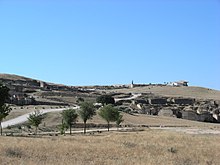Segobriga
Segobriga was an ancient city of the Celtiberians in central Spain during Roman times. Their remains are located about four kilometers south of the town of Saelices in the province of Cuenca . The city has been mentioned by various ancient authors, including the elder Pliny , who traveled to the Iberian Peninsula as a Roman imperial official around AD 74 - he referred to the city as Caput Celtiberiae .
History and localization
For a long time, this name of Pliny was read by the ancient world as the capital of the Celtiberians. With Caput, Pliny probably meant the "First City", which on his journey meant the southernmost city. The name itself is Celtic and comparable to our "Siegburg", probably a fortified hilltop settlement, which is typical of the Celtic society of the 2nd century BC. Was. For a long time, Segorbe near Valencia in eastern Spain and near the Mediterranean coast was thought to be the successor settlement of Segobrigas, but Iberians and not Celts lived there.
In the 1980s, Spanish archaeologists found an inscription on the grave of C. Grattius Glaucus on the hill Cabeza del Griego ("Head of the Greek"), a good 100 kilometers southeast of Madrid, amid Roman and Visigothic ruins . L. Grattius C. f. Gal. Glaucus was already known from another inscription in Tarraco , the capital of the Hispanic province of Tarraconensis , where the high priest of the imperial cult had died for the entire province; on his tombstone he was referred to as a Segobrigenser. It is mainly thanks to the epigrapher Géza Alföldy from the University of Heidelberg that these two places and names were brought into connection. He suspects that the high priest was the son of Gaius Glaucus and that the hill of ruins is therefore to be regarded as the ancient Segobriga.
Economical meaning
Segobriga was best known for the extraction of mirror stone ( lapis specularis ) from mine tunnels, a luxury item that was particularly valued in Rome. Pliny already reported how this transparent plaster of paris was split into plates and could be used as a window pane to protect against rain and weather or as a representative mirror. Because of its favorable location on the plateau's trade routes and its luxury goods production, Segobriga became a popular seat for the wealthy and wealthy aristocrats who very soon committed themselves to Roman tradition.
Current condition
In the meantime, this ruined city in the Tarraconian province has been largely excavated and partially reconstructed. An amphitheater , a theater , thermal baths and the forum were found , in the vicinity of which a courthouse was uncovered. Outside the city, a circus was found in 2004 , the venue for the popular chariot races. In 2006 and 2007 an extensive necropolis was excavated in the immediate vicinity of the circus . Fortunately for the archaeologists, the city had hardly been overbuilt since ancient times, only a small chapel from the Middle Ages stood there and in the 16th and 17th centuries the ruins were used as a quarry for the construction of the nearby Uclés monastery .
Among the finds are above all a great number of Roman inscriptions that tell of the luxurious life. The Romanization took about five generations, from a Celtic population known as defiant and belligerent to a loyal and privileged vassal of Rome. A Roman renewal and redesign of the city took place as early as 15 BC. BC: Terraces were laid out and all buildings were erected that were considered necessary for a Roman city. In the process, the remains of the Iberian past were probably thoroughly destroyed. The transformation did not end until the reign of Titus around 79 AD.
During the Visigoth period, Christian basilicas were built near the once rich city , in which the bishops were buried, during the Moorish rule and the reconquista of the Iberian Peninsula , the city was abandoned and fell into disrepair. Today the ruins are open to tourists.
See also
Other important Roman cities on the Iberian Peninsula are:
- Italica , Spain
- Emerita Augusta , Spain
- Tarraco , Spain
- Clunia , Spain
- Conimbriga , Portugal
literature
- Klaus-Dieter Lindsmeier: Big Business in Hispania. In: Adventure archeology . Heidelberg 2006, 1, p. 40ff. ISSN 1612-9954
- JM Abascal, M. Almagro-Gorbea et al .: Segóbriga 2007. Resumen de las intervenciones arqueológicas . Cuenca 2008: [1]
Coordinates: 39 ° 53 ′ 6.4 " N , 2 ° 48 ′ 47.8" W.


